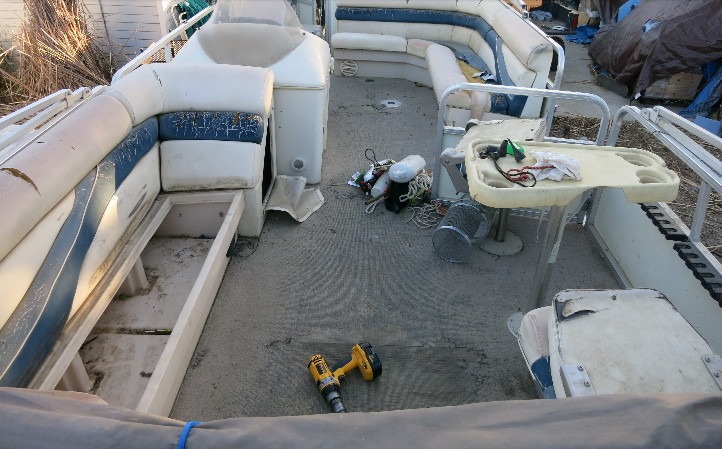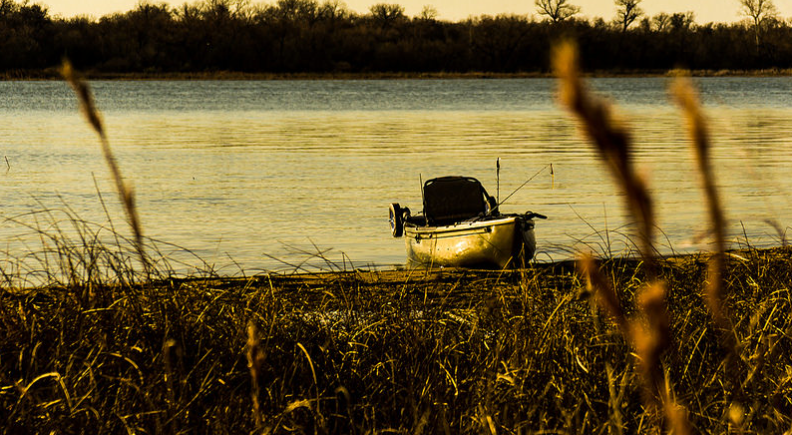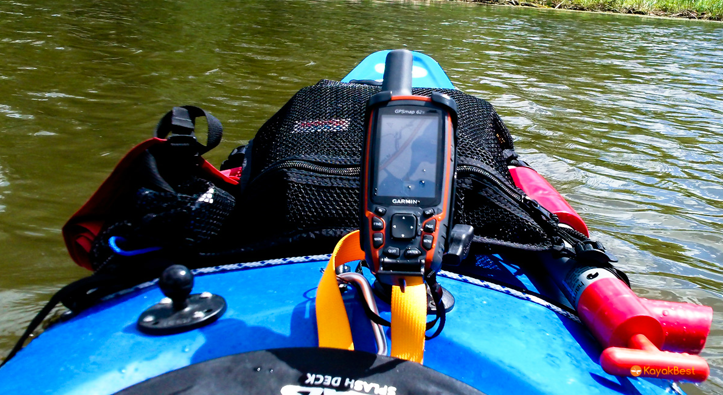Fishing, Hunting and Camping
Tips, articles and reviews by people like you.
How to Prepare for Boat Renovating
Deciding to renovate a boat offers the opportunity to provide an old junker with some tender loving care to bring it back to it’s old glory ready to provide you and your family with many more years of fun. Many boats can be worth restoring from old 60’s speed boats to fishing boats and pontoons. Some can be done in the price range that that can make it a bargain. Others may not be worth the time and effort you are going to put into it. Remember the old saying, “boats can be a money pit.
 Photo Credit: l3ricl
Photo Credit: l3ricl
Is your boat worth renovating?
If you have run into a boat for free or looking at an old one sitting in your backyard, you may have a restoration project in mind. The following 12 tips can help you decide if the project is worth it or at least, mow much effort you are going to need to put into her.
12 Tips to help you decide
Tip 1: Get the boat where you have the room to check it out. Garage is good but keep in mind that you are going to need to do some cleaning, so you may want to start outside and move it in the garage once your done with that step. You can of course do everything outside but weather and good lighting might play an effect if working on it at night.
Tip 2: Get all accumulated debris, leaves and water out of the boat, as all of these materials are known to accelerate damage. Perform a top-to-bottom cleaning of the boat so you can see all defects, wiring, etc. Yes, you will need to clean and scrub the boat down from the outside to inside, seats, steering and all.
Tip 3: Remove gas tank and dump the gas. If you are restoring a boat, the gas is probably bad. Gas lasts under a year and should actually be drained at the end of every year.
Tip 4: Remove old oil from the engine as well as the gear box (upper and lower). Replace with fresh oil.
Tip 5: Once you replaced the oil in the motor and add a little fresh gas, you need to test the motor. The boat motor is your big money item. Using bunny ears and a hose, you can try to crank the motor to make sure it will crank. If it is seized up, that is bad news and you may need to replace it. It is worth having a marine mechanic take a look at it to see if it can be saved. Note: to test the motor, you will need a battery, hopefully you have one around, if not, expect to pay around $100 for one.
Tip 6: If you decided that the motor is usable, you can move on to doing a check of the outer body of the boat (or floats/tubes/logs if a pontoon). Looking for issues with such as spot crazing and cracking of fiberglass surfaces that surround fittings, fixtures and cleats. All load-bearing boat fixtures must have a strong backing plate, so repair and replace where necessary. This can vary depending if it is fiberglass or aluminum. Most likely, you should be in good shape with the body itself though some jon boats are thinner aluminum and may be punctured. Aluminum is an easier fix though.
Tip 7: You can figure that all hoses will need to be replaced. This includes but not limited to, all gas hoses, pump primer, etc. You can make a list and have them priced out.
Tip 8: Examine the boat’s through-hull components to ensure that they remain correctly sealed. Take a close look at the boat’s seacocks to verify that they are still in working condition. Any broken parts in these areas need to be replaced. Like above, make a list to have priced out.
Tip 9: It is common for older vessels to be characterized by significant wood rot. Closely examine the boat’s decking, the seat bases as well as the transom, looking for any signs of decay or rot. You will need to remove old damaged wood from the boat and use cored composite or marine-grade pieces of plywood to perform repairs. Again, depending on the type of boat you are restoring, the price will vary a lot. Add how much wood you need and price it out.
Tip 10: YouTube has about any type of DYI video instructions you can think of. If you need help how to figure something out, YouTube should be your fist stop. I have posted a video below from YouTube on a DIY repair job on fixing a hole in a aluminum boat. These type of videos are out there for just about every issue you need to fix.
Tip 11: Next, if you plan on moving forward, I would suggest finding a good boating forum online. There are tons of forums to choose from. Do a little searching around each site and find one that fits you. Guys that belong to these forums are very knowledgeable and most will be more than happy to help you with anything you get stuck on. In fact, people would love for you to start a thread and share photos of your project. It gets them engaged in your project and they are more inclined to help you get through issues.
Tip 12: Looking for insights on a specific type of project? You can also visit Boating Mag DYI Projects. They have some good information on specific projects.
Obviously, something larger such as this boat in this piece by Fircroft is largely more challenging, however the same principals as those above apply.
So now that you have given the boat a good lookover and getting prices. You can decide if your time and money is worth the project. I gotta say, restoring a boat gives you a very satisfying feeling. Something you can be proud of. You are taking something that would end up in a junk yard and turned it into something that will provide many more years of enjoyment.
I hope these tips helped you in your venture to decide if restoring a boat I worth it. Feel free to print these tips out to use and make sure to share this page with your friends!
Kayak Fishing Checklist
 Photo by: Michael Whitacre
Photo by: Michael Whitacre
Are you new or thinking about getting into Kayak fishing? If so, there are a couple of things to think about and a few basic items you will need. The below list is a Kayak fishing checklist. It is a good idea to print out a list for quick reference of things you don’t want to forget. We have all had that “oh crap” feeling when we are out and realize we forgot something! Don’t be that person…
Tip: if you store and load your items the same way every time, they are easier to track and makes running through your checklist much quicker.
Kayak Fishing Checklist
Kayak of course
We are not going to spend a lot of time on this one. It is pretty obvious that you will have your kayak but you would be surprised… I’m assuming you already have one. Just make sure it is loaded before pulling out lol.
Paddle
You paddle is another pretty obvious item but this one can get left behind a little easier. We suggest a lightweight paddle that has a way to attach it to your Kayak for transport. Remember, the best thing you can learn is to set yourself up for success and make travel/preparing as easy as possible.
Safety Gear
You would be surprised on how many people do not pack the correct safety gear. It is not only irresponsible for you, it also would affect you family if you actually needs it.
- PFD (personal floatation device)
- A emergency whistle or airhorn
- Sun block
- Something hunter orange like a hat (in case you need to be spotted)
- Headlight if you will be fishing at night
- Knife
- Paracord, they make knives and bracelets made with paracord. Search for survival bracelets or knives.
- If possible and you have room somewhere, it is advised to take a small first aid kit
Portable GPS
 Photo by: kayakbest.com
Photo by: kayakbest.com
Many people do not think about using GPS while out kayaking but it really is a smart idea. You may think you know your local waters but they can serve couple ways. 1. of course is to know where you are. 2. You can mark honey holes or a turnoff you may not have time to explore but may want to in the future. 3. as a safety device so you can let someone know your exact location if you get into trouble. KayakBest has a good list of the top 5 GPS systems you can find here.
Tackle and Storage
So you will be in a Kayak with limited space, where do you keep your tackle, power bars and water? You want something easy to store and in the limited space you have. This of course depends on the type of fishing your doing.
Engel cooler makes a nice device that has multiple uses. It is a live well if you are using live bait or it can double as a air tight cooler for water and food. Did you catch it was air tight? The lid locks tightly so if you do capsize and end up dumping it, the cooler stays shut and protects everything in it. Great place to put your phone!
If you don’t want to put your money into one of those, I have two words for you. Milk crate… I have seen many people use these and they make an awesome storage spot. Easy to store and think of how much stuff it can hold. No worries if you have a small tackle box you want to take.
Lastly, think clothing. A cheap fishing vest or cargo pants give you a lot of room to keep lures, etc.
Camera
A camera is a must when fishing these days. When fishing by Kayak, using your phone camera is not the best choice. I always suggest always keeping them protected. We suggest something like a GoPro in a waterproof case. You could attach it to your hat or arm band to get some pretty cool shots.
Fishing License
Seems like a no brainer but make sure you have it on you. We also suggest laminating it as well since you will be on the water. Keeping it along with your wallet in something like the cooler above is recommended.
Water/Snacks
Pack plenty of water along with things like power bars. You will be doing a lot of rowing in the heat. You may be able to get away with a camelbak but a gallon water jug will be just fine (if you have the room).
Proper Attire/Weather Check
Check the weather, always dress for the elements. Remember that you will be doing a lot of rowing. Always wear a hat, wear plenty of sun screen (take extra with you) and wear polarized sunglasses. Using correct shoes is also important. Selecting the best shoes for kayaking can make your trip much more comfortable.
Lastly
Though you may have other things to add to your list, this is a good starting point. Just like everything else in life, you need to tailor the list to your needs. It’s a good idea to make your list, print it out. Laminate it and keep it with your gear.
I also want to stress that coming up with a packing and travel system will save you a ton of headaches. That way, it is always the same, you know where everything is and you will not lose things when your in a hurry.




